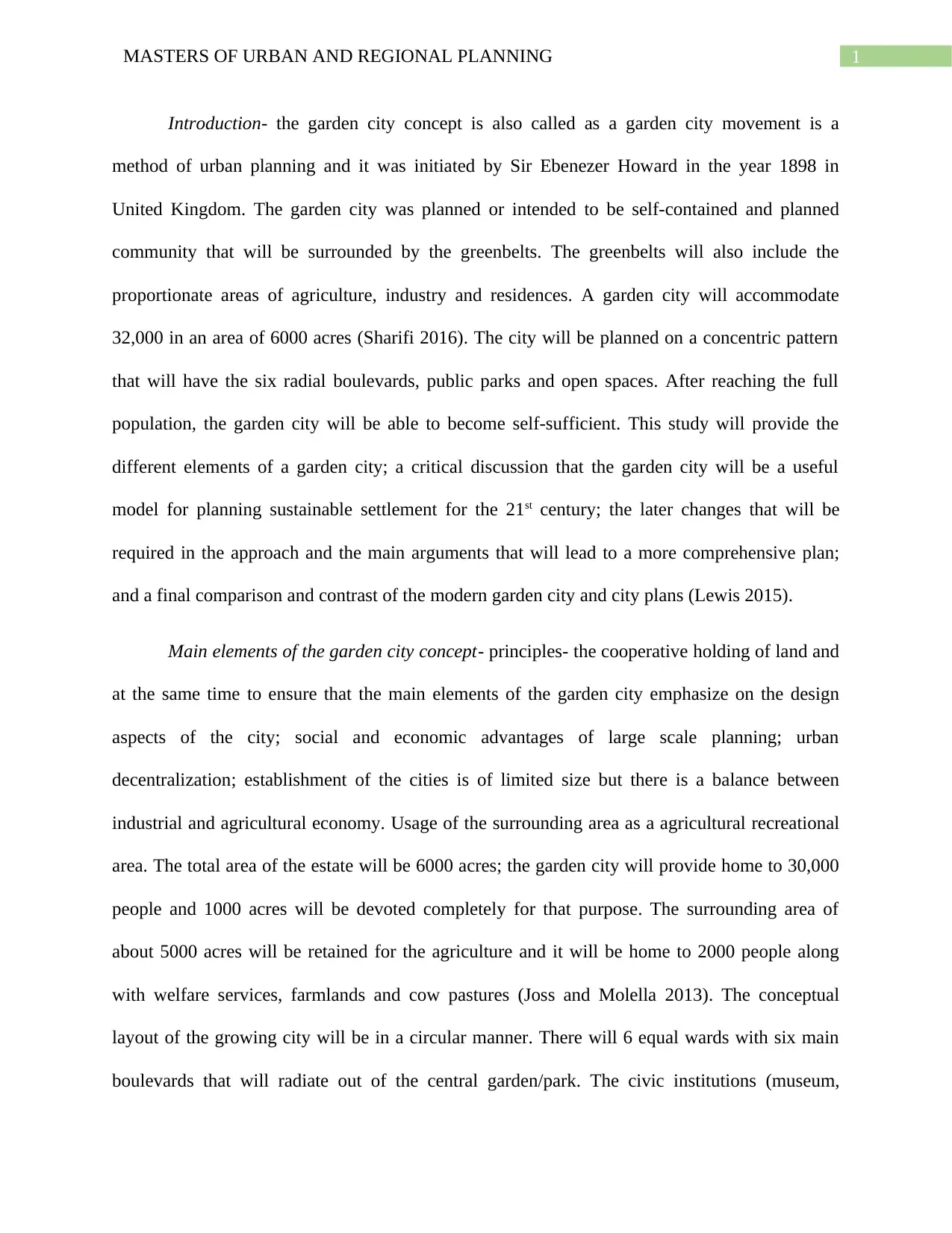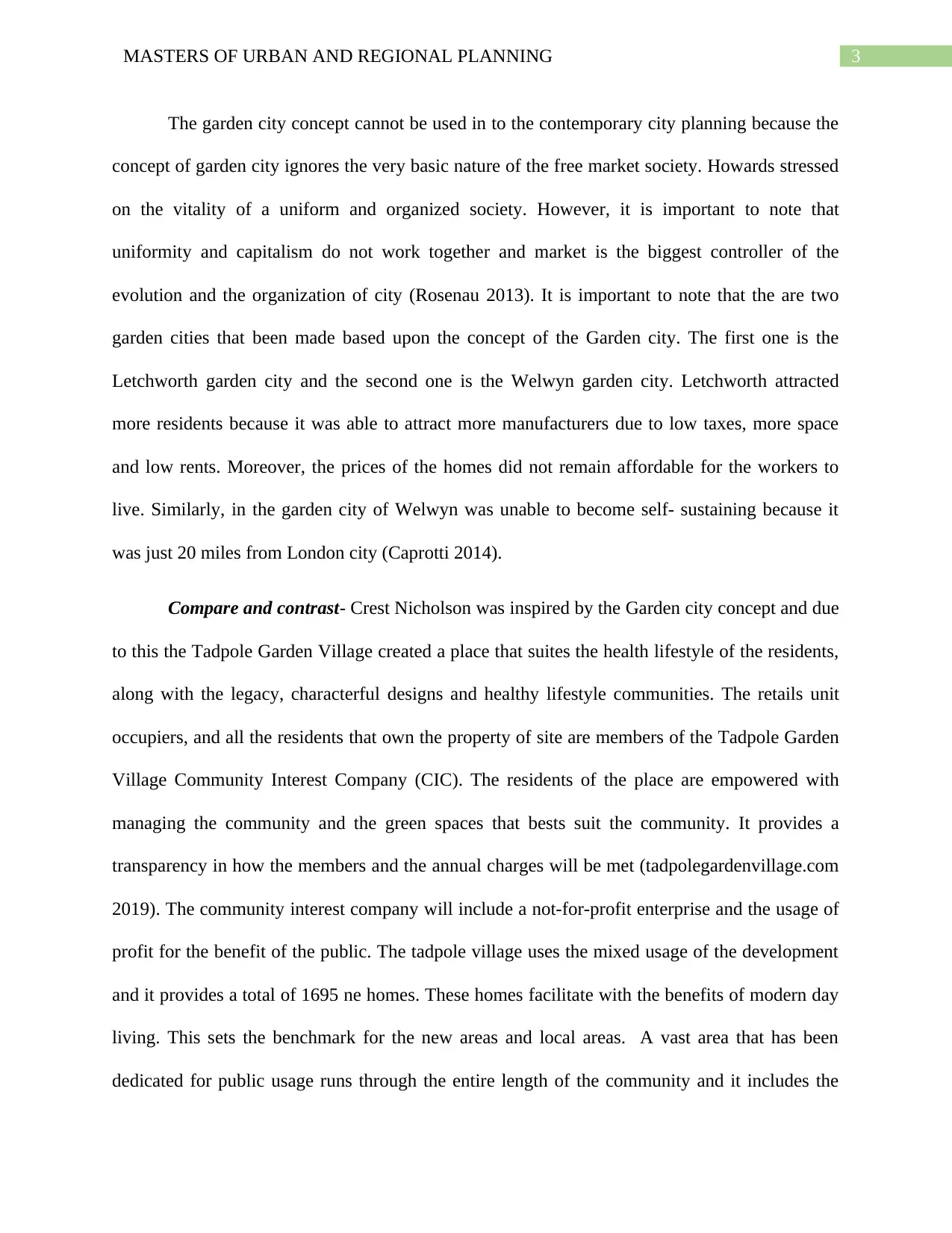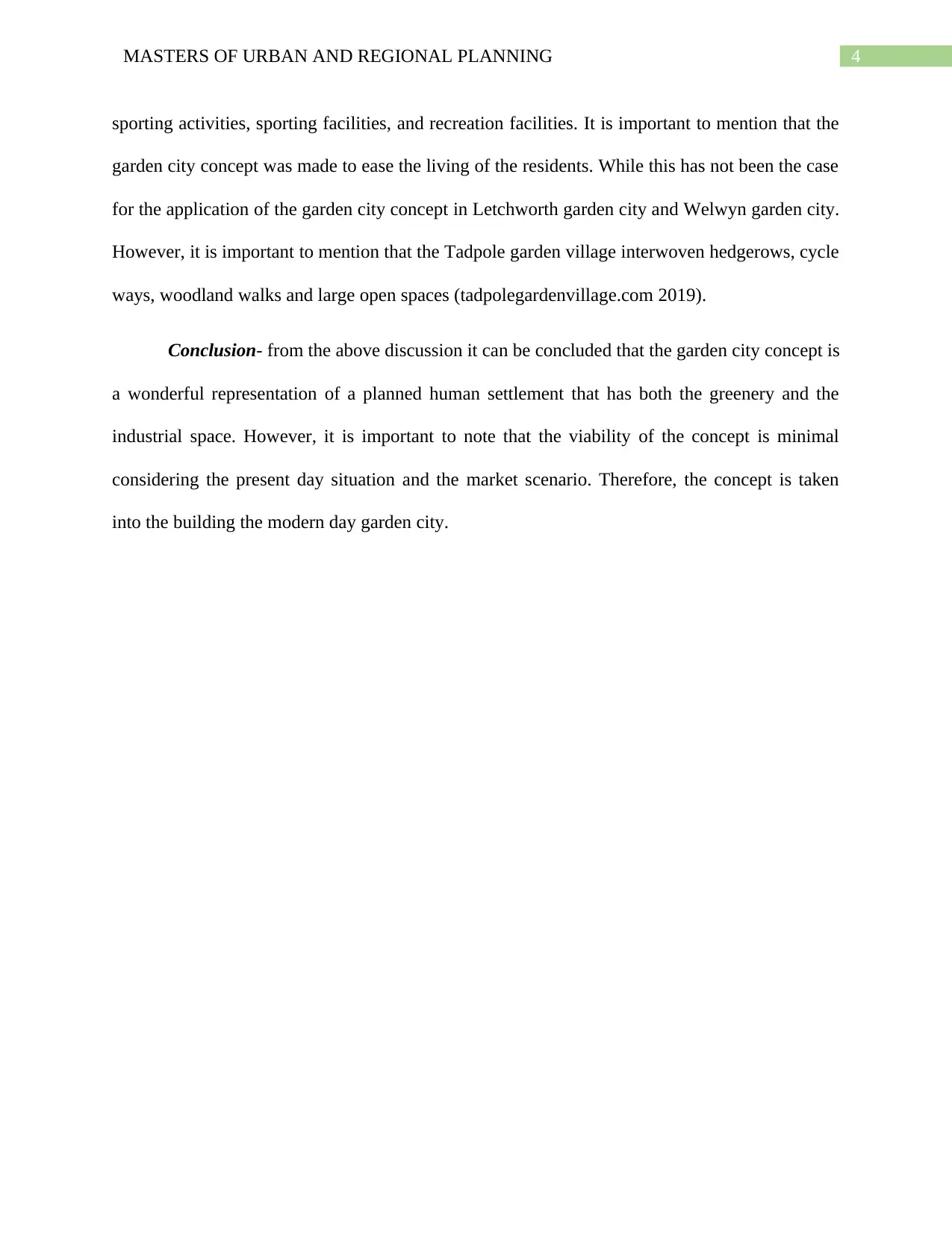Masters of Urban and Regional Planning: Garden City Concept Analysis
VerifiedAdded on 2023/01/13
|6
|1620
|67
Essay
AI Summary
This assignment delves into the Garden City concept, initiated by Sir Ebenezer Howard, exploring its core elements, including self-contained communities surrounded by greenbelts, and its concentric design. It critically evaluates the Garden City's potential as a sustainable settlement model for the 21st century, considering its strengths and weaknesses, such as its approach to urban decentralization, and the challenges of free market societies. The essay then compares and contrasts the Garden City concept with modern city plans, using examples like the Tadpole Garden Village to illustrate its practical applications and adaptations. The conclusion reflects on the viability of the Garden City concept in contemporary urban planning, acknowledging its significance while highlighting its limitations in the current market scenario.

Running head: MASTERS OF URBAN AND REGIONAL PLANNING
Masters of Urban and Regional Planning
Name of the Student:
Name of the University:
Author Note:
Masters of Urban and Regional Planning
Name of the Student:
Name of the University:
Author Note:
Paraphrase This Document
Need a fresh take? Get an instant paraphrase of this document with our AI Paraphraser

1MASTERS OF URBAN AND REGIONAL PLANNING
Introduction- the garden city concept is also called as a garden city movement is a
method of urban planning and it was initiated by Sir Ebenezer Howard in the year 1898 in
United Kingdom. The garden city was planned or intended to be self-contained and planned
community that will be surrounded by the greenbelts. The greenbelts will also include the
proportionate areas of agriculture, industry and residences. A garden city will accommodate
32,000 in an area of 6000 acres (Sharifi 2016). The city will be planned on a concentric pattern
that will have the six radial boulevards, public parks and open spaces. After reaching the full
population, the garden city will be able to become self-sufficient. This study will provide the
different elements of a garden city; a critical discussion that the garden city will be a useful
model for planning sustainable settlement for the 21st century; the later changes that will be
required in the approach and the main arguments that will lead to a more comprehensive plan;
and a final comparison and contrast of the modern garden city and city plans (Lewis 2015).
Main elements of the garden city concept- principles- the cooperative holding of land and
at the same time to ensure that the main elements of the garden city emphasize on the design
aspects of the city; social and economic advantages of large scale planning; urban
decentralization; establishment of the cities is of limited size but there is a balance between
industrial and agricultural economy. Usage of the surrounding area as a agricultural recreational
area. The total area of the estate will be 6000 acres; the garden city will provide home to 30,000
people and 1000 acres will be devoted completely for that purpose. The surrounding area of
about 5000 acres will be retained for the agriculture and it will be home to 2000 people along
with welfare services, farmlands and cow pastures (Joss and Molella 2013). The conceptual
layout of the growing city will be in a circular manner. There will 6 equal wards with six main
boulevards that will radiate out of the central garden/park. The civic institutions (museum,
Introduction- the garden city concept is also called as a garden city movement is a
method of urban planning and it was initiated by Sir Ebenezer Howard in the year 1898 in
United Kingdom. The garden city was planned or intended to be self-contained and planned
community that will be surrounded by the greenbelts. The greenbelts will also include the
proportionate areas of agriculture, industry and residences. A garden city will accommodate
32,000 in an area of 6000 acres (Sharifi 2016). The city will be planned on a concentric pattern
that will have the six radial boulevards, public parks and open spaces. After reaching the full
population, the garden city will be able to become self-sufficient. This study will provide the
different elements of a garden city; a critical discussion that the garden city will be a useful
model for planning sustainable settlement for the 21st century; the later changes that will be
required in the approach and the main arguments that will lead to a more comprehensive plan;
and a final comparison and contrast of the modern garden city and city plans (Lewis 2015).
Main elements of the garden city concept- principles- the cooperative holding of land and
at the same time to ensure that the main elements of the garden city emphasize on the design
aspects of the city; social and economic advantages of large scale planning; urban
decentralization; establishment of the cities is of limited size but there is a balance between
industrial and agricultural economy. Usage of the surrounding area as a agricultural recreational
area. The total area of the estate will be 6000 acres; the garden city will provide home to 30,000
people and 1000 acres will be devoted completely for that purpose. The surrounding area of
about 5000 acres will be retained for the agriculture and it will be home to 2000 people along
with welfare services, farmlands and cow pastures (Joss and Molella 2013). The conceptual
layout of the growing city will be in a circular manner. There will 6 equal wards with six main
boulevards that will radiate out of the central garden/park. The civic institutions (museum,

2MASTERS OF URBAN AND REGIONAL PLANNING
theatre, hospital, library, and town hall) will be placed at the central garden. The central park will
be enclosed by crystal palace that will act as an arcade for the winter gardens and the indoor
shops. The streets in between the houses will be built in a concentric ringed tree that will be lined
in an avenue. While the distance between each of the ring will be 3 to 5 km. 3-mile-long and 420
feet wide Grand avenue will be running through the centre of the churches, schools and houses
so that will act as a continuous public park. It was superior because well-lit streets, amusements,
social opportunities, high wages, opportunities for work. Abundant of water, healthfulness, fresh
air, natural beauty (Barnett 2016.).
Critical discussion on Green city sustainable settlements- The model of garden city is
informing and it provides proposals for a sensitive environmental development. It includes the
concern of inclusiveness and cultural diversity. The amenity rich and dense town centres along
with the civic gatherings provide small multi-centred gathering areas that help in communicating
with the transport/transit corridors, high quality telecommunication, and affordable distributive
energy opportunities, cycleability/walkability and the ability of the human settlements to
transcend the cultural and ethnic diversity divides (Westerink et al. 2013). The distributed energy
system as well as the improvement in the energy storage at the infrastructure and household
scales is increasingly pervasive towards the creation of the garden cites. However, the garden
city concept presents some of the challenges in terms of presence of slums, dirty air, high rents,
isolation from crowds, distances form work. Moreover, there is a general decay, lack of
amusements, low wages, lack of drainage, lack of society and dullness. Thus, even if the concept
is futuristic enough considering the present time and the garden city lacks its suitability (Petcou
and Petrescu 2015).
theatre, hospital, library, and town hall) will be placed at the central garden. The central park will
be enclosed by crystal palace that will act as an arcade for the winter gardens and the indoor
shops. The streets in between the houses will be built in a concentric ringed tree that will be lined
in an avenue. While the distance between each of the ring will be 3 to 5 km. 3-mile-long and 420
feet wide Grand avenue will be running through the centre of the churches, schools and houses
so that will act as a continuous public park. It was superior because well-lit streets, amusements,
social opportunities, high wages, opportunities for work. Abundant of water, healthfulness, fresh
air, natural beauty (Barnett 2016.).
Critical discussion on Green city sustainable settlements- The model of garden city is
informing and it provides proposals for a sensitive environmental development. It includes the
concern of inclusiveness and cultural diversity. The amenity rich and dense town centres along
with the civic gatherings provide small multi-centred gathering areas that help in communicating
with the transport/transit corridors, high quality telecommunication, and affordable distributive
energy opportunities, cycleability/walkability and the ability of the human settlements to
transcend the cultural and ethnic diversity divides (Westerink et al. 2013). The distributed energy
system as well as the improvement in the energy storage at the infrastructure and household
scales is increasingly pervasive towards the creation of the garden cites. However, the garden
city concept presents some of the challenges in terms of presence of slums, dirty air, high rents,
isolation from crowds, distances form work. Moreover, there is a general decay, lack of
amusements, low wages, lack of drainage, lack of society and dullness. Thus, even if the concept
is futuristic enough considering the present time and the garden city lacks its suitability (Petcou
and Petrescu 2015).
⊘ This is a preview!⊘
Do you want full access?
Subscribe today to unlock all pages.

Trusted by 1+ million students worldwide

3MASTERS OF URBAN AND REGIONAL PLANNING
The garden city concept cannot be used in to the contemporary city planning because the
concept of garden city ignores the very basic nature of the free market society. Howards stressed
on the vitality of a uniform and organized society. However, it is important to note that
uniformity and capitalism do not work together and market is the biggest controller of the
evolution and the organization of city (Rosenau 2013). It is important to note that the are two
garden cities that been made based upon the concept of the Garden city. The first one is the
Letchworth garden city and the second one is the Welwyn garden city. Letchworth attracted
more residents because it was able to attract more manufacturers due to low taxes, more space
and low rents. Moreover, the prices of the homes did not remain affordable for the workers to
live. Similarly, in the garden city of Welwyn was unable to become self- sustaining because it
was just 20 miles from London city (Caprotti 2014).
Compare and contrast- Crest Nicholson was inspired by the Garden city concept and due
to this the Tadpole Garden Village created a place that suites the health lifestyle of the residents,
along with the legacy, characterful designs and healthy lifestyle communities. The retails unit
occupiers, and all the residents that own the property of site are members of the Tadpole Garden
Village Community Interest Company (CIC). The residents of the place are empowered with
managing the community and the green spaces that bests suit the community. It provides a
transparency in how the members and the annual charges will be met (tadpolegardenvillage.com
2019). The community interest company will include a not-for-profit enterprise and the usage of
profit for the benefit of the public. The tadpole village uses the mixed usage of the development
and it provides a total of 1695 ne homes. These homes facilitate with the benefits of modern day
living. This sets the benchmark for the new areas and local areas. A vast area that has been
dedicated for public usage runs through the entire length of the community and it includes the
The garden city concept cannot be used in to the contemporary city planning because the
concept of garden city ignores the very basic nature of the free market society. Howards stressed
on the vitality of a uniform and organized society. However, it is important to note that
uniformity and capitalism do not work together and market is the biggest controller of the
evolution and the organization of city (Rosenau 2013). It is important to note that the are two
garden cities that been made based upon the concept of the Garden city. The first one is the
Letchworth garden city and the second one is the Welwyn garden city. Letchworth attracted
more residents because it was able to attract more manufacturers due to low taxes, more space
and low rents. Moreover, the prices of the homes did not remain affordable for the workers to
live. Similarly, in the garden city of Welwyn was unable to become self- sustaining because it
was just 20 miles from London city (Caprotti 2014).
Compare and contrast- Crest Nicholson was inspired by the Garden city concept and due
to this the Tadpole Garden Village created a place that suites the health lifestyle of the residents,
along with the legacy, characterful designs and healthy lifestyle communities. The retails unit
occupiers, and all the residents that own the property of site are members of the Tadpole Garden
Village Community Interest Company (CIC). The residents of the place are empowered with
managing the community and the green spaces that bests suit the community. It provides a
transparency in how the members and the annual charges will be met (tadpolegardenvillage.com
2019). The community interest company will include a not-for-profit enterprise and the usage of
profit for the benefit of the public. The tadpole village uses the mixed usage of the development
and it provides a total of 1695 ne homes. These homes facilitate with the benefits of modern day
living. This sets the benchmark for the new areas and local areas. A vast area that has been
dedicated for public usage runs through the entire length of the community and it includes the
Paraphrase This Document
Need a fresh take? Get an instant paraphrase of this document with our AI Paraphraser

4MASTERS OF URBAN AND REGIONAL PLANNING
sporting activities, sporting facilities, and recreation facilities. It is important to mention that the
garden city concept was made to ease the living of the residents. While this has not been the case
for the application of the garden city concept in Letchworth garden city and Welwyn garden city.
However, it is important to mention that the Tadpole garden village interwoven hedgerows, cycle
ways, woodland walks and large open spaces (tadpolegardenvillage.com 2019).
Conclusion- from the above discussion it can be concluded that the garden city concept is
a wonderful representation of a planned human settlement that has both the greenery and the
industrial space. However, it is important to note that the viability of the concept is minimal
considering the present day situation and the market scenario. Therefore, the concept is taken
into the building the modern day garden city.
sporting activities, sporting facilities, and recreation facilities. It is important to mention that the
garden city concept was made to ease the living of the residents. While this has not been the case
for the application of the garden city concept in Letchworth garden city and Welwyn garden city.
However, it is important to mention that the Tadpole garden village interwoven hedgerows, cycle
ways, woodland walks and large open spaces (tadpolegardenvillage.com 2019).
Conclusion- from the above discussion it can be concluded that the garden city concept is
a wonderful representation of a planned human settlement that has both the greenery and the
industrial space. However, it is important to note that the viability of the concept is minimal
considering the present day situation and the market scenario. Therefore, the concept is taken
into the building the modern day garden city.

5MASTERS OF URBAN AND REGIONAL PLANNING
Reference
Barnett, J., 2016. City design: Modernist, traditional, green and systems perspectives. Routledge.
Caprotti, F., 2014. Critical research on eco-cities? A walk through the Sino-Singapore Tianjin
Eco-City, China. Cities, 36, pp.10-17.
Joss, S. and Molella, A.P., 2013. The eco-city as urban technology: Perspectives on Caofeidian
international eco-city (China). Journal of Urban Technology, 20(1), pp.115-137.
Lewis, J., 2015. Preserving and maintaining the concept of Letchworth Garden City. Planning
Perspectives, 30(1), pp.153-163.
Petcou, C. and Petrescu, D.M., 2015. R-URBAN or how to co-produce a resilient city.
Ephemera: Theory and Politics in Organization, 15(1), pp.249-262.
Rosenau, H., 2013. The ideal city: Its architectural evolution in Europe. Routledge.
Sharifi, A., 2016. From Garden City to Eco-urbanism: The quest for sustainable neighborhood
development. Sustainable Cities and Society, 20, pp.1-16.
tadpolegardenvillage.com, 2019. The legacy - Tadpole Garden Village. [online] Tadpole Garden
Village. Available at: https://tadpolegardenvillage.com/the-legacy/ [Accessed 3 Apr. 2019].
Westerink, J., Haase, D., Bauer, A., Ravetz, J., Jarrige, F. and Aalbers, C.B., 2013. Dealing with
sustainability trade-offs of the compact city in peri-urban planning across European city regions.
European Planning Studies, 21(4), pp.473-497.
Reference
Barnett, J., 2016. City design: Modernist, traditional, green and systems perspectives. Routledge.
Caprotti, F., 2014. Critical research on eco-cities? A walk through the Sino-Singapore Tianjin
Eco-City, China. Cities, 36, pp.10-17.
Joss, S. and Molella, A.P., 2013. The eco-city as urban technology: Perspectives on Caofeidian
international eco-city (China). Journal of Urban Technology, 20(1), pp.115-137.
Lewis, J., 2015. Preserving and maintaining the concept of Letchworth Garden City. Planning
Perspectives, 30(1), pp.153-163.
Petcou, C. and Petrescu, D.M., 2015. R-URBAN or how to co-produce a resilient city.
Ephemera: Theory and Politics in Organization, 15(1), pp.249-262.
Rosenau, H., 2013. The ideal city: Its architectural evolution in Europe. Routledge.
Sharifi, A., 2016. From Garden City to Eco-urbanism: The quest for sustainable neighborhood
development. Sustainable Cities and Society, 20, pp.1-16.
tadpolegardenvillage.com, 2019. The legacy - Tadpole Garden Village. [online] Tadpole Garden
Village. Available at: https://tadpolegardenvillage.com/the-legacy/ [Accessed 3 Apr. 2019].
Westerink, J., Haase, D., Bauer, A., Ravetz, J., Jarrige, F. and Aalbers, C.B., 2013. Dealing with
sustainability trade-offs of the compact city in peri-urban planning across European city regions.
European Planning Studies, 21(4), pp.473-497.
⊘ This is a preview!⊘
Do you want full access?
Subscribe today to unlock all pages.

Trusted by 1+ million students worldwide
1 out of 6
Your All-in-One AI-Powered Toolkit for Academic Success.
+13062052269
info@desklib.com
Available 24*7 on WhatsApp / Email
![[object Object]](/_next/static/media/star-bottom.7253800d.svg)
Unlock your academic potential
Copyright © 2020–2025 A2Z Services. All Rights Reserved. Developed and managed by ZUCOL.